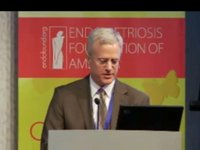Our next speaker is Dr. William Rodgers. Dr. Rodgers is Head of Pathology at Lenox Hill Hospital. He is also a collaborator in our project of tissue bank; exclusively on endometriosis as far as our foundation is concerned. I would like to acknowledge my department chief, Dr. Michael Divon who has been always supportive. My colleague Elizabeth Poyner, always worked together as surgeon oncologists, a great convert to the cause of endometriosis, an oncologist , it is a plus. And as importantly I would like to also acknowledge Ms. Janet Rosel who is here, who is single-handedly underwriting this project. She did not know I was going to announce her name, but she has just come in, she is sitting at the back. I would like to give her applause for this.
Dr. Rodgers please.
William Rodgers, MD, PhD
It is indeed a pleasure to be here this morning to be invited by the foundation to speak. I am actually honored to share the podium with the distinguished scientists that have been presenting work. I want to apologize in advance, I am not providing any answers. I want to really raise questions and raise doubts, perhaps even about the approach that has typically been taken to studying endometriosis and other complex diseases by pointing out some of the issues involved in those studies.
Endometriosis, particularly with a topic that is the point of this symposium, is an unusual disease. It is very prevalent. It is present in a large number of women if the definition is finding endometrial tissue that is outside of the uterus. But for the various conditions or problems that women have with endometriosis, the location, the extent of the lesions is very important as Dr. Seckin pointed out.
This is a cross-section of the major organs in the female pelvis, the bladder with the ureter. This would be the outside of the body. This is the uterus, this black area is where the cervix was in this patient. She had cervical cancer, and the vagina. Just below the vagina is the bowel and rectum. The space around these organs are very small spaces, all the tissues are adjacent to one another and that is the location where lesions that cause problems with lower pelvic pain and endometriosis reside. They can be relatively small lesions in this area and cause a great deal of difficulty or they can be very large lesions that actually mimic cancer and produce tumors. This is a very difficult area of the body to work in. It is very difficult part of the body to understand. The embryology in this area is very, very complex. It is a place where you have multiple openings to the outside body forming during development. You have fusion of various tubular structures that are really beyond what can be discussed in a few minutes. But suffice it to say that there are a large number of embryologic events that happen, and the remnants of those events all kind of cluster around in this lower pelvic area, just like in the digestive area you have very complex anatomy, and very complex remnants of embryologic tissue. Those tissues are often referred to in the context of this disease as mullerian remnants. They are tissues that are derived from the perimysium ____ ducts that fuse to become the uterine tubes and the uterus proper. And those remnants are present in the female pelvis and are now known to play a very important role in the development of ovarian cancer.
What is endometriosis? We use the term, we talk about its prevalence being great. Is endometriosis a normal situation in women? What is the reason that women menstruate? Is there a function for that? Not all mammals menstruate. Do they menstruate to the extent that primates do? Those are important questions because they speak to why you do have menstruation. Is retrograde menstruation a consequence of having to menstruate? And are there systems that are in place in humans that are meant to deal with the problem of retrograde menstruation? Is endometriosis a problem with the regulation of this problem associated with menstruation? Or is it a unique disease that is inherent in the endometrium? It usually is assumed that it is primarily an endometrial problem rather than perhaps a peritoneal problem. I just raise that question. Is endometriotic tissue abnormal? Or is it normal tissue that is in an abnormal environment? Is it a result of abnormal physiology or immunology? Is it all three of these things? I tend to believe that maybe the different conditions that are associated with endometriosis actually are the result of different fundamental causes or differences.
Most of the speakers this morning, and in fact most researchers in endometriosis worldwide, primarily study normal endometrial tissue. Now they use in very elegant studies to mimic endometriotic lesions to gain insight into what might be occurring in endometriosis. This shows the histological appearance of the endometrium during the reproductive cycle and you can see that there is a very dramatic change in both the thickness and in the appearance of these cells which represents the coordinate expression of hundreds of different genes and proteins. So it is not surprising that if you look for individual proteins or genes expression in these areas that you will find differences between these tissues. I believe what most of our scientists have been showing us is as they use fishing devices with many, many, many more hooks you are able to capture many more of those hundreds of gene products or genes or modified messages that are altered in the normal differentiation of the endometrium. You have to keep that in mind as you ask the questions; is normal endometrial tissue that is present in the pelvis different or diseased? Or is it just the same as the endometrium?
I became interested in endometriosis early on as a cancer researcher. I thought that it would be useful to compare endometriotic tissue to endometrial cancer tissue to try to find unique genes that would be abnormally expressed in endometrial cancer believing that endometriosis would be very different than cancer. What I found very quickly was that normal endometrium and endometriotic tissue expressed all of the genes and proteins that were thought to be very important and invasion metastasis at that time which is about 1987 or so. Those were matrix metalloproteinases. We published this paper with Kevin Osteen really demonstrating that the expression of certain MMPs was restricted to really the proliferative phases, and other MMPs were found in the secretory phase. The ones that were found in the proliferative phase were the ones that were thought to be very fundamental in invasion metastasis of cancers. In fact they were listed by some of the speakers as being associated with cancer invasion metastasis. But they are all expressed in the endometrium. The endometrium is a very unique tissue that renews itself entirely every month. There is almost no other tissue in the human body that does that and it probably has some unique features that allow that to happen and a unique role that requires that it happens in humans.
By taking apart the endometrium you can do very elegant studies, looking for what the control elements are; the signals that are responsible for the interaction of the stroma and the epithelium in this tissue. All tissues are comprised of epithelium in stroma, even cancer tissues. But in the endometrium the function of the stroma seems to be fairly specific and special and the endometrial stroma, unlike fibroblasts, do play a specific role in regulating, in this case, progesterone response of the stroma controlling the matrix metalloproteinase expression in the endometrium.
The phenotype of endometriotic lesions when you look at them in patients that have persistent disease is that they are primarily proliferative. You always find proliferative phenotype endometriotic lesions in women that have persistent endometriosis. That makes sense. You would think that if it is going to stay there and grow, it has to be proliferative, and it is, it is not a surprise. Sometimes endometriotic tissue looks almost identical to normal endometrium. More typically it is a little bit altered and the altered appearance mimics all the changes that you see in normal endometrium with metaplasias and other changes. But what you find in endometriosis, in fact, what you have to recognize if you are going to diagnose endometriosis is the presence of what looks like normal endometrial stroma associated with endometrial glands. That is a definition that has been used but it may not be the right way to approach the definition. With respect to MMP expression you find that in very few cases where we had endometrial tissue and endometrial stromal tissue we found that there was a dyssynchrony between the expression of metalloproteinases that were proliferative compared to the secretory phenotype of the women in their normal endometrium. For instance in this case endometrium at day 16 from a woman that has endometriosis was expressing the proliferative phenotype of metalloproteinases in her peritoneum. So there is a dyssynchrony between the function of the two.
Is endometriosis neoplastic? I think this is an important question because when molecular studies have been done to look for clonality within endometriosis they find that some lesions are clonal within the peritoneum, some of the time. That is kind of typical of clinical studies done in endometriosis. You find that something is expressed some or most of the time, most of the time that you look for it. But with respect to clonality in many other organ systems there are mixed tumors that occur. There are benign tumors often and sometimes they are mixed malignant tumors. For instance, in the breast there is a fibroadenoma that is a mixed stromal and epithelial tumor. In the endometrium you have endometriosis, which is a mixed stromal and epithelial lesion or tumor. I think you have to keep in mind is this a process that may be more typical of a low-grade malignancy than a condition. In endometriosis there is an entity that is now recognized, it is atypical endometriosis that are lesions that look abnormal and have the mutations that are typically present in clear cell carcinomas and sometimes serous carcinomas. This is an example of an endometriotic lesion that is expressing all sorts of P53. There are a number of unusual associations of rare tumors with endometriosis, for instance adenosarcoma, which is a malignant tumor of the stroma, and questionably abnormal epithelial elements. This is very often found in association with what look like are benign endometriotic lesions but it is a very rare tumor.
So to conclude, I just want to summarize what a number of questions are. I think the origin of endometriosis is still up for grabs. It does occur by way of retrograde menstruation but because of the presence of large numbers of mullerian remnants in some women origin directly from the peritoneum is something that needs to be considered. The classification of the disease I think needs to be reinvestigated. I think just finding a single endometriotic lesion, or in some cases, people believe that just finding hemosiderin-laden macrophages in the right clinical context is sufficient for diagnosis of endometriosis. The spectrum of disease is so wide that I think there needs to be ways to classify it a little more precisely.
And then, how does the disease progress relative to the reproductive cycle within pregnancy and with regard to the immune status of individual groups of patients? How can you answer those questions? I think the only way, and this is the main message I think that I have for you today, is that you cannot do these studies without endometriotic tissue. A little of the data that was presented today really involves study of endometrial tissue that is intact. It is a very difficult disease to study because the tissue is very, very tiny. Even in lesions that are fairly large you do not have the advantage of large amounts of tumor tissue that are present when you are studying cancer. So it is a much more challenging disease to study, much more challenging than say ovarian cancer is, and we all know how difficult that is to study.
I think the approach that we have to use is exactly what was presented today. You have to take a systems biology approach to understand what the elements are that are abnormal in endometriosis and then you have to begin to study abnormal tissue of the disease rather than models of normal endometrium that is present in experimental systems.
Thank you.










